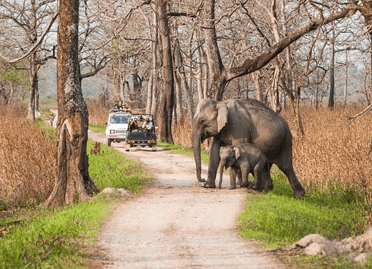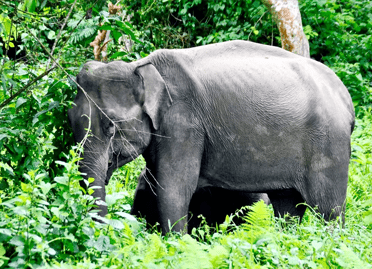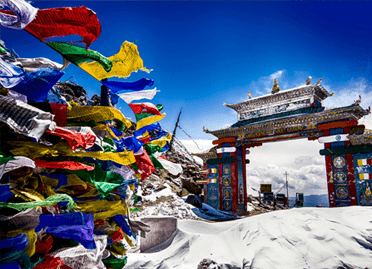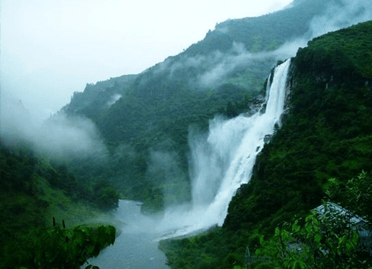Where am I : India Tour Packages » Most Popular Packages » Nameri Tour Packages
View Details

Destinations Covered : Manas » Guwahati » Kaziranga » Nameri
View Details

Destinations Covered : Kolkata » Sunderbans » Guwahati » Kaziranga » Nameri
Nameri Tourism
In India, Assam is one of the largest states, and it is the area that houses the river valleys of Brahmaputra. This region is famous for its wildlife, archaeological sites, and tea plantations. Guwahati, Assam's largest city, boasts silk bazaars and the hilltop Kamakhya Temple in the west. There are cultural festivals like Bihu, which is a sight to behold. There are also famous and beautiful national parks where you can quickly see rhinos, tigers, and elephants. Among these, Nameri is very popular with tourists; Nameri is a paradise for lovers of birds or nature. Nameri is located in the eastern foothills of the Himalayas, in the Sonitpur district of the Indian state of Assam. It is considered the second-largest tiger reserve in Assam. Nameri National Park is an excellent destination for nature lovers. Many tourists keep coming here to see the park's natural beauty. The magnificent National Park is a beautiful place that makes a person wants to behold it with his eyes. Suppose you want to spend some time peacefully close to nature. Then it would help if you are planning Nameri tourism.
History of Nameri
This fantastic and beautiful national park is located at a distance of about 35km from Tezpur. The nearest village to Nameri National Park is Chariduar. Nameri National Park, with the adjoining Pakhui Sanctuary in Arunachal Pradesh, has a spread of more than 1,000 km2. This beautiful park is situated on the eastern border of the Assam valley and hilly Arunachal Pradesh. Nameri is connected to the northern border with the Pakhui Wildlife Sanctuary in Arunachal Pradesh. The park extends from the east and southwest banks of the Bor Dikorai River to the left bank of the Jia Bharali River to the south bank of the Balipara Reserve Forest. Assamese and Missing tribal villages surround this Nameri National Park. The Nameri location comprises tropical evergreen, semi-evergreen, moist deciduous forests and narrow strips of open grassland with cane and bamboo breaks and rivers. Grasslands cover less than 10% of the total area of ??the park. But semi-evergreen and moist deciduous species dominate the region. The Jia Bhareli River flows along the boundaries of the park. Apart from the Jia-Bhoroli River, some other tributaries, Doigurung, Diji, Nameri, Dinai, and Dikorai, cross the parking area. The landscape is mainly comprised of semi-evergreen trees, humid deciduous forests with extensions of cane, bamboo, and narrow meadows that open to the sky along the rivers. It is like a paradise for bird watchers as it boasts nearly 300 species, including hornbills, black storks, picoibis, turdoides, and caradrinos. You can also find varied fauna such as tigers, leopards, gaurs, wild boars, sloth bears, Himalayan bears, and elephants. It was declared a Forest Reserve in 1978. Two decades later, it was converted into a National Park. It is a beautiful experience to join the jungle safari and explore the park's rich biodiversity.
Why should visit Nameri National Park?
Nameri National Park is a famous wildlife sanctuary in North-East India. Nameri National Park is also renowned as one of the most preferred tourist destinations in North-East India.
Whether you are a nature lover, wildlife lover, tourist, or photographer, this national park captivates every visitor with its beauty. Thousands of visitors visit this national park to enjoy the wildlife safaris, eco camps, and rare species sighting of wildlife. If you also want to get lost in nature's unique beauty and behold its beauty, then you must visit Nameri National Park. Here we will know about the details of this park.
Interesting Facts
- Nameri National Park was established in 1978 and covered an area of ??200 sq ft.
- There are more than 500 animal and plant species in the park.
- Most white teak, hollock, and Nahor plant species are found here.
- Nameri National Park is to enjoy adventure and beautiful plains.
- For bird lovers, this place is no less than a paradise.
- Nameri Park was established in 1978 in the village of Charidaur at the foothills of the Himalayas.
- This national park is lovely and surrounded by dense forests and green plains.
In 2002, 26 tigers were recorded in the park. You can also find the sambar, the leopard tiger, the clouded leopard, the Indian buffalo, the Chinese pangolin, the jackal, the capped langur, the wild boar, the sloth bear, the hog deer, the dhole, the Indian giant squirrel, and others. The place is a paradise for some 300 species of birds, many of which are migratory. Reptiles also have a place in the Nameri Park, such as the queen cobra, vipers, the python, and various species of turtles. The park area is intertwined with the Jia-Bhoroli River and its tributaries. These rivers grow impressively during the rainy season, leaving certain park areas inaccessible. Nameri Park is famous for its herds of Indian or Asian elephants. It has a high population density of these animals. Still, with the decrease in forest areas, elephants sometimes invade inhabited villages, and this has caused conservationists to pay attention to the place. The best season to visit Nameri Park is between November and May. The nearest airport is in Tezpur, about 35 kilometers away, and receives flights from Kolkata. And the closest train station is in Rangapara, about 21 kilometers from the park. Perhaps the best option would be to get to Tezpur by bus or plane since regular buses take you to Nameri Park. Usually, visits to the park are made in boats on the river, passing through the forests and enjoying a landscape of great beauty. This camp has the basics, but it can be a good option to rent the boats early in the morning or organize a tour. Another option is to spend the night in Tezpur or Balipara. In the park, you can do activities such as rafting, traveling about 13 kilometers along the river, and observing the park's heart. It is also possible to take a walk but always accompanied by a guide.
Wildlife of Nameri
Nameri National Park provides habitat for Bengal tiger, Indian leopard, spotted leopard, marbled cat, leopard cat, hog deer, sambar, dhole, gaur, barking deer, wild boar, sloth bear, Himalayan black bear, capped langur, and Indian giant squirrel. The white-winged wood duck, excellent foot hornbill, scalloped hornbill, rufous-necked hornbill, black stork, ibisbill, blue-bearded bee-eaters, babblers, plovers, and many other birds are also present.
Nameri National Park flora
Nameri National Park has tropical evergreen and semi-evergreen forests mix with moist deciduous forests. The most common and prominent plant species in the park include Albizia lucida, Albizia procera, Amora wallichi, Artocarpus chapalasha, Baccuria sapida, Biscophia javanica, Bombax ceiba, Canarium strictum, Castanopsis indica, Cordia dichotoma, syndrocaella, Dendrocaella, Dendrocaella, and dendroca. Indica, Duabanga grandiflora, Duabanga soneratoides, Diosoxylum procerum, Endospermum Chinese, Lagerstromia flos-regina, Litsia sebifera, Mesua feria, etc.
The vegetation of Nameri National Park consists of three main types of vegetation:
- Flooded alluvial grasslands consist of large thickets of short Grass and dense, tall elephantine grasses.
- Evergreen trees characterize temperate evergreen forests.
- Semi-evergreen forests.
- In addition to this magnificent spectacle of grasses and forests, the marshes of Kaziranga National Park are covered with a blanket of water lilies, hyacinths, and lotuses, giving this place a great dimension.
- You will also come across climbing plants that add a certain natural beauty to Nameri National Park.
Fauna of Nameri National Park
The park provides natural habitat to many species of mammals and is one of the most critical conservation areas for tigers and elephants. Other species include leopard, clouded leopard, Indian bison, pangolin, Indian wild dog, civet cat, capped langur, jackal, sambar, etc. Snakes, crocodiles, and turtles are also found in the park. Many species of mammals are seen in Nameri National Park. Including Indian elephant, leopard, clouded leopard, tiger, fishing cat, golden cat, marbled cat, jungle cat, Himalayan black bear, sloth bear, Indian bison, wild dog (dhole), they are barking deer, sambar, hog deer, Indian hare, capped langur, hispid hare, Assamese macaque, hog badger, rhesus macaque, Himalayan crestless porcupine, otters, squirrel, and wild boar. Reptiles include reticulated python, Indian cobra, king cobra, Burmese python, banded krait, common blind snake, pit viper, flying snake, common monitor lizard, and water monitor lizard. Nameri has endangered species. These include Tricarinate Hill Turtle, Indian Eyed Turtle, Malayan Box Turtle, and Peacock Softshell Turtle. Talking about birds, the Nameri National Park is home to more than 300 species of birds. The White-winged Wood Duck, Gardener Hornbill, Great Pied Hornbill, Rufous Naked Hornbill, Ibis Bill, Blue Bearded Bee, Black Stork, Babbler, Plover, and many more birds make Nameri their home. Due to this, it is a paradise for bird watchers.
Birds of Nameri National Park
There are hundreds of species of birds, the most important of which is the white-winged duck. Other important bird species like Mountain Imperial Pigeon, Blue-naped Pitta, Slender-billed Oriole, Hill Blue Flycatcher, White-crowned Forktail, Sultan Tit, Black-bellied Tern, Jordan Babbler, Rufous-backed Sibia, Yellow-bellied Flowerpecker, Red-Throated Pipit, Long-billed Plover, Ibisbill, etc.
Rafting
In the eco-camp, you can arrange for rafting and river rafting. The route runs along the quiet and calm Bhareli River, the distance of the course is 18 km, and the duration is 2-3 hours. Rafting can also be combined with a picnic on the shore.
Jungle walk during Nameri tourism
Representatives of the eco-camp also organize walking tours through the jungle with an armed guide. The walk takes about three hours, including walking to the banks of the Bhareli River, crossing the river by boat, and walking through the jungle. It is recommended to start the walk early in the morning, which will make it more likely to meet wild animals, although the chances of meeting a real tiger are not so great.
Other nearby attractions of Nameri National Park
Agnigarh
The city of Tezpur, situated on the banks of the Brahmaputra River and surrounded by hills, can be seen from the Agnigarh Fort. With the height of the fort, the whole town looks very picturesque. It looks like a beautiful park, in which there are many statues depicting mythology. It is said that Asura Banasura built this fort to separate his daughter Usha from her lover, Aniruddha, grandson of Lord Krishna. For this, Banasura had put a guard of fire around the palace. Circular stairs can reach the top of this hill. The idols of Usha and Anirudh are enshrined here, which is a tribute to these lovers. Other exciting places include the open theatre, giant mushroom-shaped umbrellas, and a spectacular waterfall. This place is a romantic destination that will cherish the memories of young lovers.
Kamakhya temple
Kamakhya Devi, the temple, is a renowned pilgrimage site for Hindus. A guided tour of this temple will introduce you to the poignant legend of Shiva and Shakti. Indeed, Shati was the darling of Shiva, but the divine suitor was not in the small papers of his father-in-law Daksha, who did not accept their union. During a yajna sacrifice that Daksha organized in honor of Vishnu, the two spouses were humiliated for not being summoned. Shanti, seized with anger, threw herself into the sacrificial fire and the temple of Kamakhya marks where the goddess's uterus and vagina would have fallen. Since then, thousands of Hindus have visited the temple, which has become the symbol of feminine energy and fertility.
Bomdila
Bomdila town is one of the best tourist places near Nameri. Bomdila's rich culture, snow-capped Himalayas, and lush green landscape make it a famous sightseeing destination for those seeking natural beauty. The western Kameng valley and the cloud-covered Nechipupas are a sight from Bomdila. This place is also known for its beautiful apple orchards, which attract many tourists. The state's highest peaks, Kangte and Gorichen, are visible from Bomdila, where the Miji, Monpa, Sherdukpen, Khawas, and Aka tribes are mainly settled. Other important places of interest include the Ethnographic Museum and various craft centers showcasing the city's rich cultural heritage.
The temple of Janardan
Even if the pilgrimage means nothing to you, you will stroll with pleasure in this magnificent temple of Vishnu, which faces the Brahmaputra River, between valleys and wooded hills. The softness of the landscapes, the touching spirituality, and the comings and goings of the colored boats in the river give the temple a magnificent and romantic setting.
The Bamuni Hills
The Bamuni Hills, situated on the right side of the Brahmaputra River, is a center of unique attraction for tourists. The fragmented sculptures and stone carvings of the 9th and 10th centuries attract the attention of tourists. The beautiful stone carvings on the walls of Bamuni Hills captivate the visitors with their artistic beauty. There is also a wiead belief that these ruins could also be a temple of Lord Vishnu. Legend has it that Aniruddha, the grandson of Lord Krishna, fell in love with the daughter of Banasur, but Banasur did not accept this relationship.
Climate
Tourism in Nameri National Park is dependent on the vagaries of the weather. Avoid going during the monsoon, which begins in July and ends in October. The region is at the mercy of heavy flooding during this season, not to mention the risk of landslides. If you want to travel in dry weather with mild temperatures, choose winter to go there. Even if the mornings are foggy, the sun shows itself in the middle of the day. It is cool or slightly chilly from October to March, but the thermometer never drops below six o C. Summer is marked by the first rains in May and ends in July. The temperature varies between 32o and 38o C. Although this heat seems scorching to the eyes of a European, Assam enjoys a more moderate summer compared to the other provinces of India.
How to Reach Nameri?
By Train
The Rangapara Railway Station is the nearest railway station for tourists to reach Nameri National Park, which is about 21 km from Nameri National Park. The road well connects Rangapara Railway Station to Nameri National Park. Passengers from Rangapara Railway Station will get you a cab to Nameri Park. The distance of the park from the station is 35 km, which is straightforward to reach.
By road
The road system is excellent for tourists to reach Nameri National Park. Nameri National Park is well connected by road network to major cities and tourist places. For which many governments and privately operated vehicles are available. Who frequents the Nameri National Park at intervals?
By Airplane
For tourists to reach Nameri National Park, the nearest domestic airport to the National Park is located at Tezpur by air. And is 40 km away from Tezpur Park. After reaching here, you can take a cab to Nameri National Park. You can also come from Guwahati International Airport. The distance between Guwahati and Tezpur is 170 km. And from Tezpur, you get a cab to the National Park.
Final thoughts
Nameri Tourism gained importance by sighting white-winged wood duck species here. Declaration as a national park in 1998 paved the way for several surveys in Nameri National Park. Due to this, tigers and elephants were seen. Tell the tourists that the temperature in and around Nameri National Park remains normal throughout the year. It is the monsoon season if you tell the right time to visit Nameri National Park. It can be called anytime from September to March. In summer too many people come to visit. Because being quite large, the temperature remains normal throughout the year.
Speak to our Experts!
Instant Quote, Best Deals - 100% Customizable, Includes hotels + car + guides Cost depends on various factors like, number of people you are, travel dates, category of hotel and transportation etc.Drop your Inquiry to get the best deals as per your requirements. 100% Satisfaction Guaranteed. Rated 5* in TripAdvisor.





